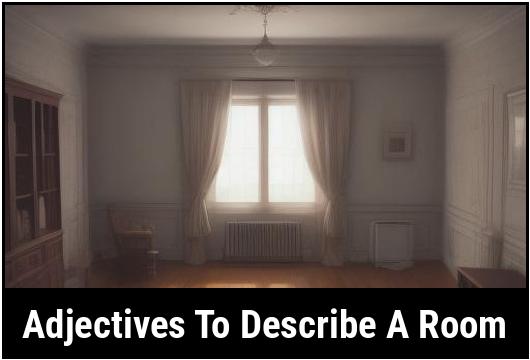- You are here:
- Home »
- adjectives
- » 31 Adjectives To Describe A Room

31 Adjectives To Describe A Room
Describing a room involves using evocative language that paints a vibrant image in the reader or listener’s mind. Adjectives play a crucial role in achieving this by providing detailed descriptions that establish mood, ambiance, and character of the space. In this comprehensive guide, we will explore the importance of utilizing adjectives to describe a room, how to choose the right adjectives for the purpose, and the various types of adjectives that can effectively convey the essence of a room.
Key Takeaways
- Adjectives are essential for creating vivid and descriptive portrayals of a room.
- Proper selection and use of adjectives can evoke specific emotions linked to the room’s ambiance and characteristics.
- When describing a room, adjectives should consider aspects such as color, size, shape, texture, and ambiance.
Adjectives To Describe A Room
1. Spacious
A spacious room exudes an open and unrestricted feeling. It allows for free movement and provides ample breathing space. Use this adjective to describe rooms that offer plenty of size and comfort.
2. Cozy
A cozy room envelopes its inhabitants with warmth, comfort, and a sense of intimacy. It’s a space that welcomes you with open arms, making you feel safe and content.
3. Bright
A room filled with natural light or well-lit by artificial means can be described as bright. This adjective conveys a sense of cheerfulness and liveliness.
4. Serene
A serene room offers a tranquil and calming atmosphere. It’s a sanctuary where one can escape the chaos of the outside world and find peace within.
5. Modern
A modern room showcases sleek lines, minimalist design, and contemporary elements. It is characterized by its clean, polished, and up-to-date appearance.
6. Elegant
An elegant room exudes sophistication, refinement, and grace. It is tastefully adorned with high-quality furnishings and exudes a sense of timeless beauty.
7. Vibrant
A vibrant room is filled with energy, liveliness, and a burst of colors. It is a space that stimulates the senses and uplifts the mood.
8. Welcoming
A welcoming room radiates a warm and inviting atmosphere. It embraces visitors and makes them feel comfortable and at ease.
9. Serendipitous
A serendipitous room surprises and delights with unexpected elements. It may feature unique artworks, quirky furniture, or whimsical details that add a touch of magic and wonder.
10. Organized
An organized room is characterized by orderliness, meticulousness, and a sense of neatness. Everything has its place, contributing to a sense of calm and efficiency.
11. Tranquil
A tranquil room offers a sense of peacefulness and quietude. It is a space that promotes relaxation and fosters a meditative ambiance.
12. Airy
An airy room boasts a light and breezy atmosphere. It is well-ventilated and offers a refreshing and rejuvenating experience.
13. Invigorating
An invigorating room energizes and revitalizes its occupants. It may feature splashes of vibrant colors, uplifting scents, or lively patterns.
14. Vintage
A vintage room evokes nostalgia and a sense of charm from bygone eras. It may showcase antique furniture, retro decor, and period accents.
15. Eclectic
An eclectic room combines various styles, eras, or elements to create a harmonious and visually interesting space. It is a room that celebrates diversity and individuality.
16. Transepochal
A transepochal room seamlessly blends elements from different time periods. It creates a unique fusion of historical periods, resulting in an enchanting and eclectic atmosphere.
17. Artistic
An artistic room showcases creativity, imagination, and self-expression. It may feature original artworks, sculptures, or unique installations that serve as captivating focal points.
18. Sophisticated
A sophisticated room exudes elegance, refinement, and cultivated taste. It signifies a high level of style and maturity.
19. Rustic
A rustic room embodies a cozy and charming countryside aesthetic. It may feature natural materials, rough-hewn textures, and earthy tones that create a warm and inviting atmosphere.
20. Luxurious
A luxurious room exudes opulence, indulgence, and extravagance. It showcases high-end materials, lavish decor, and exquisite craftsmanship.
21. Enchanting
An enchanting room captivates and mesmerizes with its ethereal beauty. It creates a sense of wonder and transports its visitors into a magical world.
22. Welcoming
A welcoming room radiates a warm and inviting atmosphere. It embraces visitors and makes them feel comfortable and at ease.
23. Tranquil
A tranquil room offers a sense of peacefulness and quietude. It is a space that promotes relaxation and fosters a meditative ambiance.
24. Whimsical
A whimsical room is characterized by its playfulness, imagination, and fanciful elements. It may feature fairy lights, vibrant patterns, or whimsical decor that adds a touch of charm.
25. Zen
A Zen room creates a serene and balanced atmosphere, inspired by Eastern philosophies. It encourages mindfulness, simplicity, and a sense of harmony.
26. Intimate
An intimate room embraces a sense of coziness, privacy, and close connection. It is a space that encourages personal interactions and meaningful conversations.
27. Inviting
An inviting room entices and beckons with its warmth and allure. It is a space that makes you want to stay and linger, willingly drawing you in.
28. Refreshing
A refreshing room rejuvenates and revitalizes the senses. It may feature cool colors, natural elements, and invigorating scents that evoke a sense of renewal.
29. Enveloping
An enveloping room wraps its occupants in a sense of security, comfort, and protection. It provides a sheltering and nurturing ambiance.
30. Charming
A charming room possesses an irresistible appeal characterized by its attractiveness, grace, and allure. It exudes a heartwarming and delightful atmosphere.
31. Captivating
A captivating room holds one’s attention and interest through its enchanting qualities. It creates an atmosphere that is impossible to resist, effortlessly drawing you in and captivating your senses.
Why Use Adjectives To Describe A Room
Adjectives are fundamental tools in the descriptive writer’s arsenal. When used to describe a room, they serve as the building blocks of imagery, allowing the audience to visualize and connect with the space being described. Adjectives enable the communicator to convey the atmosphere, mood, and overall impression of the room, sparking the reader’s imagination and creating a sensory experience. They play a significant role in setting the tone for the description, whether it be calm and tranquil, vibrant and energetic, or eerie and mysterious. By utilizing adjectives, the writer can effectively transport the audience into the room, making them feel as though they are experiencing it firsthand.
How To Choose The Right Adjective To Describe A Room
Selecting the appropriate adjectives to describe a room involves careful consideration of various elements and characteristics that define the space. When choosing adjectives, it is essential to take into account the room’s size, shape, color scheme, lighting, decor, and overall ambiance. Furthermore, understanding the emotional response the room evokes is crucial in selecting adjectives that accurately capture its essence. By aligning the chosen adjectives with these considerations, the description becomes more comprehensive and engaging.
Types Of Adjectives For Describing A Room
1. Descriptive Adjectives
Descriptive adjectives are the most common type used to characterize a room. They provide specific details about the room’s appearance, such as its size, shape, color, and texture. Descriptive adjectives can range from simple to complex, allowing for a nuanced portrayal of the room’s physical attributes. For instance, a room may be described as "spacious," "rectangular," "soothing blue," or "velvety."
2. Emotional Adjectives
Emotional adjectives are employed to convey the feelings and atmosphere within the room. These adjectives elicit an emotional response in the reader, emphasizing the ambiance and mood of the space. Examples of emotional adjectives include "serene," "cozy," "intimate," "invigorating," and "mysterious."
3. Spatial Adjectives
Spatial adjectives are used to depict the spatial qualities of the room, including its layout, organization, and orientation. These adjectives enable the reader to visualize the arrangement and configuration of the room. Spatial adjectives may encompass terms like "open-plan," "circular," "symmetrical," "crowded," or "cluttered."
4. Sensory Adjectives
Sensory adjectives aim to evoke the reader’s senses by describing the sensory experiences associated with the room. These adjectives appeal to sight, sound, touch, smell, and taste, thereby creating a multi-dimensional representation of the room. Examples of sensory adjectives include "gleaming," "hushed," "silken," "fragrant," and "tasty."
5. Architectural Adjectives
Architectural adjectives focus on the structural and design elements of the room, highlighting its architectural details, style, and period. These adjectives assist in conveying the aesthetic and historical aspects of the room’s construction and design. They encompass terms such as "Gothic," "ornate," "minimalist," "Victorian," and "industrial."
6. Qualifying Adjectives
Qualifying adjectives serve to qualify or restrict the meaning of the noun they modify. These adjectives refine the description by adding specific details or limitations. For instance, a room may be described as "modern," "historic," "cosy," "sophisticated," or "family-friendly."
Describing a room effectively requires the skillful application of adjectives to evoke vivid and immersive imagery. Adjectives enable the communicator to convey not only the physical attributes of the room but also its emotional ambiance, spatial layout, sensory experiences, architectural style, and qualifying characteristics. By understanding the significance of adjectives in room descriptions and selecting adjectives that align with the room’s various aspects, communicators can create evocative and captivating portrayals of any space. Through the careful selection and utilization of adjectives, a room description can transcend mere words and transport the audience into the room, engendering a deeper appreciation for its unique qualities.
Using Adjectives Effectively
When describing a room, it is important to choose the right adjectives to effectively communicate the atmosphere, appearance, and overall impression of the space. Adjectives play a crucial role in painting a vivid picture in the reader or listener’s mind, allowing them to imagine the room’s qualities without actually being present.
Examples of Adjectives for Different Types of rooms
Living room:
- Cozy – A living room that is warm and inviting, with comfortable furniture and soft lighting.
- Spacious – A living room with ample space, allowing freedom of movement.
- Elegant – A living room that is stylish and sophisticated, with high-end furniture and decorative elements.
- Modern – A living room characterized by contemporary design and sleek furniture.
- Welcoming – A living room that makes guests feel comfortable and at ease.
- Vibrant – A living room filled with colors that create a lively and energetic atmosphere.
- Relaxing – A living room designed to evoke a sense of calm and serenity.
- Airy – A living room that feels light and breezy, with good natural light and well-ventilated.
- Family-friendly – A living room designed to accommodate the needs of all family members, including children.
- Inviting – A living room that beckons people to come in and relax.
Bedroom:
- Serene – A bedroom that creates a peaceful and tranquil atmosphere.
- Cozy – A bedroom that feels warm and snug, perfect for a good night’s sleep.
- Luxurious – A bedroom characterized by opulent design and high-quality furnishings.
- Serene – A bedroom that creates a peaceful and tranquil atmosphere.
- Minimalistic – A bedroom with a clean and uncluttered style, minimal furniture and decor.
- Stylish – A bedroom that exudes contemporary style and good taste.
- Comfortable – A bedroom that provides all the necessary amenities and a comfortable sleeping environment.
- Restful – A bedroom that promotes relaxation and rest.
- Personalized – A bedroom that reflects the owner’s personality and individual style.
- Calming – A bedroom that has a soothing effect on the mind and helps to reduce stress.
Kitchen:
- Functional – A kitchen that is well-organized and designed for efficient food preparation.
- Spacious – A kitchen with plenty of room for cooking and movement.
- Cozy – A small and compact kitchen that still feels comfortable and inviting.
- Modern – A kitchen with sleek, contemporary design and high-tech appliances.
- Well-equipped – A kitchen that has all the necessary tools and appliances for cooking.
- Bright – A kitchen with abundant natural light or well-lit with artificial lighting.
- Clean – A kitchen that is spotless and well-maintained.
- Organized – A kitchen with everything in its proper place and easy to find.
- Chef’s – A kitchen designed for serious cooking enthusiasts, equipped with professional-grade appliances.
- Family-friendly – A kitchen that is suitable for use by the whole family, with features like a breakfast bar or kitchen island for seating.
Bathroom:
- Clean – A bathroom that is spotless and hygienic.
- Spa-like – A bathroom reminiscent of a luxury spa, with features like a jacuzzi tub or rainfall showerhead.
- Small – A bathroom with limited space.
- Elegant – A bathroom with stylish design and upscale fixtures.
- Refreshing – A bathroom with a bright and invigorating atmosphere.
- Serene – A bathroom that promotes relaxation and peace.
- Well-maintained – A bathroom that is in good condition and properly cared for.
- Modern – A bathroom with contemporary design and cutting-edge features.
- Inviting – A bathroom that makes you want to spend time in it, with cozy towels and scented candles.
- Functional – A bathroom that is designed with practicality in mind, allowing for easy use and maintenance.
Office:
- Productive – An office space that promotes focus and efficiency.
- Organized – An office that is neat and well-arranged, helping to improve workflow.
- Inspiring – An office that stimulates creativity and motivation.
- Spacious – An office with ample room for work and movement.
- Professional – An office that conveys a sense of seriousness and importance.
- Quiet – An office that is free from distractions and noise.
- Well-equipped – An office that has all the necessary tools and equipment for work.
- Comfortable – An office that provides a comfortable and ergonomic working environment.
- Bright – An office with good natural or artificial lighting.
- Efficient – An office that is designed with productivity in mind, minimizing wasted time and effort.
Common Mistakes in using adjectives to describe the room
-
Overusing the same adjectives: It is easy to fall into the trap of using the same adjectives repeatedly when describing a room. However, this can make the description monotonous and repetitive. Instead, try to use a variety of adjectives to create a more interesting and engaging description.
-
Using vague or general adjectives: Avoid using adjectives that are too broad or lack specificity. For example, describing a room as "nice" or "good" doesn’t provide much insight or detail. Instead, opt for adjectives that paint a clearer picture and convey a more specific impression.
-
Neglecting to consider sensory adjectives: Describing a room solely based on visual appearance is a missed opportunity. Include adjectives that describe how the room smells, sounds, and feels. This will make the description more immersive and vivid.
-
Failing to consider the room’s purpose: Different rooms serve different functions, and the choice of adjectives should reflect that. For example, a bedroom should evoke a sense of restfulness and relaxation, while an office should exude professionalism and efficiency. Tailor the adjectives to match the room’s intended purpose.
-
Use figurative language: To add depth and creativity to your descriptions, consider using figurative language such as similes and metaphors. For example, instead of saying a room is "bright," you can say it is "bright as the morning sun." This creates a more vivid image in the reader’s mind.
-
Appeal to different senses: As mentioned earlier, incorporating sensory adjectives will make your description more engaging and realistic. Consider how the room smells, sounds, and feels, in addition to how it looks. This will help the reader to better imagine being in the room.
-
Be specific and precise: Rather than using generic adjectives, strive to be more specific and precise in your descriptions. Instead of saying a room is "clean," you can say it is "pristine," "immaculate," or "spotless." This adds depth and richness to the description.
-
Consider the room’s character: Every room has its own unique character and charm. Take into account the room’s architectural features, decor, and overall style when choosing adjectives to describe it. This will help capture the essence and personality of the space.
-
Use adjectives to create a narrative: Instead of simply listing adjectives, use them to tell a story or create a narrative. For example, instead of saying a living room is "cozy," you can say it is "cozy, with a fireplace inviting you to curl up on the soft, plush couch with a warm blanket and a good book." This paints a more vivid picture and engages the reader’s imagination.
Exercises And Practice
-
Choose a room in your own home and make a list of adjectives to describe it. Consider the room’s purpose, atmosphere, and style. Challenge yourself to come up with at least ten descriptive adjectives.
-
Take a photograph of a room in a magazine or online and write a paragraph describing it using adjectives. Pay attention to the room’s details, colors, furniture, and overall ambiance. Experiment with different adjectives to capture the room’s essence.
-
Ask a friend or family member to describe a room they recently visited. Based on their description, try to recreate the room in your mind using adjectives. Compare your version with theirs and discuss the different impressions and perspectives.
Conclusion
Choosing the right adjectives to describe a room is crucial in effectively communicating its atmosphere, appearance, and overall impression. By being specific, considering sensory adjectives, and tailoring the adjectives to match the room’s purpose, you can create a vivid and engaging description. Avoid common mistakes such as overusing similar adjectives or using vague language. By practicing and honing your skills in describing rooms, you can become more adept at painting a realistic and immersive picture in the reader or listener’s mind.
FAQS On Adjectives To Describe A Room
What Are Some Common Adjectives Used To Describe A Room’s Atmosphere?
Some common adjectives used to describe a room’s atmosphere include cozy, inviting, airy, welcoming, and serene.
How Can I Convey A Room’s Size And Space Using Adjectives?
Adjectives such as spacious, expansive, roomy, or cavernous can be used to convey a sense of size and space in a room. On the other hand, adjectives like cramped, tight, or confined can be used to describe a smaller or more limited space.
What Adjectives Can I Use To Describe A Room’s Décor Or Style?
Depending on the specific décor or style of a room, adjectives such as modern, traditional, eclectic, minimalist, or rustic can be used. Other adjectives like elegant, stylish, cozy, or vibrant can also be used to describe a room’s overall look and feel.
How Can I Use Adjectives To Describe A Room’s Lighting?
Adjectives such as bright, well-lit, dim, or ambient can be used to describe a room’s lighting. Other adjectives like natural, artificial, or subtle can also be used to specify the source or type of lighting in a room.
What Are Some Descriptive Adjectives For A Room’s Color Scheme?
Some descriptive adjectives for a room’s color scheme include vibrant, muted, neutral, monochromatic, or bold. Specific color adjectives such as warm, cool, earthy, or pastel can also be used to describe the dominant colors in a room.








